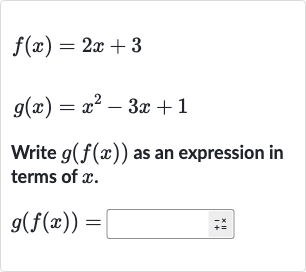AI tutor
Full solution
Q. Write as an expression in terms of .
- Identify functions: Identify the functions to be composed.We have two functions:We need to find the composition of , which means we will substitute into .
- Substitute into : Substitute into . To find , we replace every instance of in with the expression for . So,
- Expand : Expand the expression
- Distribute : Distribute the across the terms in the parentheses.
- Combine terms: Combine all the terms to get the final expression for .
- Simplify expression: Simplify the expression by combining like terms.
More problems from Compare linear and exponential growth
QuestionGet tutor help
QuestionGet tutor help
QuestionGet tutor help
QuestionGet tutor help
QuestionGet tutor help
QuestionGet tutor help
QuestionGet tutor help

